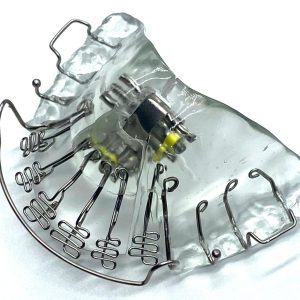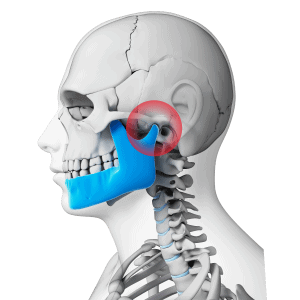
TMJ can be cured permanently using a combination of specialized palatal expanders, posture correction, myofunctional therapy and breathing exercises. The orthodontic expanders create more space and balance in the dental arches, jaws and nasal passageways. More space reduces upper airway resistance and allows for better alignment of the jaws, teeth and tongue. The result is better overall jaw, neck and back posture and restored comfort in the TMJ and muscles of mastication. In rare cases surgery may also be necessary including tongue advancement, UPPP and nasal turbinate reduction and sinus ablation.
Palatal Expanders for TMJ Problems
The most popular adult palatal expanders for TMJ are the DNA appliance and Homeoblock device. Myofunctional therapy is used to strengthen the tongue and improve it’s posture. When the tongue is weak and there is little room in the mouth and palate, the tongue falls back into the throat and obstructs the airway. When the tongue obstructs the airway (during sleep), the result is mouth breathing and lots of teeth clenching.
Video about TMJ and Fixing it with Expanders

What Causes TMJ Symptoms?
TMJ problems are caused by structural issues in the head, neck and back stemming from childhood growth and development. TMJ is related to airway resistance problems causes by childhood underdevelopment in the mouth, jaws and nasal passageways. Conditions such as a small mouth, tied tongue, mouth breathing and poor tongue posture need to be corrected to be successful in permanently fixing TMJ pain. All other TMJ treatments are only going to manage TMJ symptoms and pain.
Tongue Function is the key to Fixing TMJ

People who have proper tongue posture do not clench their teeth and have TMJ pain. What is Myofunctional Therapy? Believe it or not, there are professionals called “Myofunctional Therapists” who work with people who have tongue function problems. Think of them as physical therapists for the tongue. Myofunctional Therapists are usually trained first as dental hygienists, dentists or speech and language pathologists before getting an Orofacial Myofunctional Therapy (OMT) certificate.
What is a tongue tie?
A tongue tie is a tight fiber that attaches the tongue to the front part of the lower jaw bone. The presence or absence of a tongue tie is not what is important. How well the tongue functions and moves is what matters. Tongue muscle tone, strength and range of motion are critical. Healthy swallow pattern. Can the tongue easily lift up into the palate and create an air-tight seal? Does the tongue have a wide shape and good tone during movement? Or does it get pointy and curl down when it is pushed out of the mouth?
Tongue Tie and Posture
Tied tongues do not move well. Tongue pressure during talking, swallowing and eating stimulates spacious development of the mouth, nose and face at a very young age. If the tongue cannot move well, the jaws and face will not grow large enough for healthy breathing patterns. People will have small breathing passageways. They will get choked by a large tongue especially during sleep. The tongue is the root cause of mouth breathing, airway resistance, snoring and many sleep problems.
What is Myofunctional Therapy?
Myofunctional Therapy is everything about strengthening the tongue, correcting tongue function and perfecting tongue posture. But why do we care so much about the tongue? When the tongue is working properly we do not see:
- Mouth Breathing
- TMJ pain and teeth clenching
- Sleep apnea
- Poor facial profile and jaw asymmetries
- Posture problems related to the head and neck
- Crooked teeth and biting problems
Usually, by the time myofunctional therapy is considered for adults, some or all of the above problems are present. Other therapies and treatments in addition to myofunctional therapy are going to be necessary. Most of these treatments are structurally related, for example crooked teeth and poor facial profile. That is where palatal expanders and breathing exercises and rarely surgery become necessary. Without the use of palatal expanders, myofunctional therapy and breathing exercises, TMJ problems can only be managed. The most common management treatment for TMJ is a bite splint or occlusal guard.
Managing TMJ and the Affect on Your Life?

Temporomandibular joint disorder, or TMJ, is a condition that affects the joint connecting the jaw to the skull. It can cause a range of symptoms, including pain and discomfort in the jaw, face, neck, and head; problems with biting and chewing; and difficulty opening and closing the mouth. These symptoms can significantly impact your quality of life, making everyday activities such as talking, eating, and even smiling difficult and uncomfortable. While there is no permanent cure for TMJ, there are a number of treatments that can help to manage the symptoms and improve your quality of life.
Practice Good Oral Hygiene
Good oral hygiene is an essential part of maintaining overall health, and it is especially important for people with TMJ. Brushing your teeth twice a day and flossing daily can help to remove plaque and bacteria, which can lead to tooth decay and gum disease. Using mouthwash can also help to kill bacteria and freshen breath. In addition to maintaining good oral hygiene, it is important to avoid hard or chewy foods, as they can put extra strain on the jaw joint and exacerbate TMJ symptoms. Stick to softer foods and cut your food into smaller pieces to make chewing easier.
Apply Heat or Ice to the Affected Area
Applying heat or ice to the affected area can help to reduce pain and discomfort associated with TMJ. Heat can help to relax the muscles, while ice can reduce inflammation and numb pain. Which method you use will depend on your personal preference and which feels more comfortable for you. Some people find that alternating between heat and ice can be effective.
Try Over-the-Counter Pain Medication
Non-steroidal anti-inflammatory drugs (NSAIDs), such as ibuprofen, can help to reduce pain and swelling associated with TMJ. These medications are available over the counter and can be taken according to the instructions on the label. It is important to follow the recommended dosage and not to take more than the recommended amount.
Consider Physical Therapy
Physical therapy can be an effective treatment for TMJ. A physical therapist can teach you exercises to stretch and strengthen the muscles in the jaw and neck, which can help to reduce TMJ symptoms. These exercises may include jaw stretches, neck stretches, and facial muscle strengthening. In addition to exercises, a physical therapist may also use techniques such as massage and heat or cold therapy to help relieve muscle tension and reduce pain.
Try Relaxation Techniques
Stress and tension can exacerbate TMJ symptoms, so finding ways to relax can be beneficial. This can include activities such as meditation, yoga, or deep breathing exercises. It may also be helpful to practice stress-reduction techniques such as progressive muscle relaxation or guided imagery.
Use a Occlusal Splint or Mouthguard
A splint or mouthguard is a device that is worn over the teeth to hold the jaw in a comfortable position. These devices can help to reduce strain on the temporomandibular joint and alleviate pain. Splints and mouthguards can be custom-made by a dental or medical professional, or they can be purchased over the counter. Over-the-counter mouth guards usually do not work as well.
Consult a Dental or Medical Professional
If your TMJ symptoms are severe or not responding to other treatments, it may be necessary to seek the help of a dental or medical professional. They may recommend more specialized treatments such as injections, surgery, or prescription medications. It is important to work with a healthcare provider who is experienced in treating TMJ to ensure that you receive the most appropriate care.
